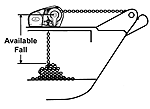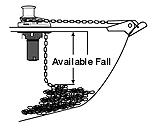In order to select the proper windlass for your boat, three questions should
be answered:
1. How long is my
boat?
Use the selection guide to determine the general size of windlass to be used
for your boat length and displacement.
For example, if you have a 33ft/ 10m boat, a 600lb/ 270kg pull windlass
(Sprint 600) would typically be selected. Adjust the windlass size if
necessary, based on your answers to questions two and three below.
2. How long is the anchor rode you wish to use and
will it fit into your locker?
Begin by examining the depth of the anchor locker to determine the amount of
'fall' available. The fall is the vertical distance between the top of the
anchor locker and the top of the anchor rode when it is completely stored
inside the locker. This measurement is important in determining whether your
boat will be best suited for a vertical or horizontal
windlass.
Horizontal Windlass
|
|
The Horizontal windlass is a no-nonsense
design widely used by boaters requiring optimum performance from their
anchoring system.
 Boaters who frequently anchor, especially in deep
water, require a no hassle self-tailing system. The horizontal windlass
offers the best performance with small or unusual locker designs. As the
anchor rode enters the gypsy it makes a 90º turn and feeds directly into
the anchor locker. a minimum fall of 12"/ 30cm is recommended. Boaters who frequently anchor, especially in deep
water, require a no hassle self-tailing system. The horizontal windlass
offers the best performance with small or unusual locker designs. As the
anchor rode enters the gypsy it makes a 90º turn and feeds directly into
the anchor locker. a minimum fall of 12"/ 30cm is recommended. |
Vertical Windlass
 |
Vertical windlasses provide aesthetic
value and offer the added security of the anchor rode making a 180º wrap
around the gypsy. The inherent design of the vertical windlass requires
at least 12"/ 30cm of fall.
This is to allow gravity to properly self-tail the anchor rode through a
90º vertical turn into the anchor locker. Additionally, nylon line is
lightweight and a short fall in a vertical windlass system might prevent
the rode from feeding properly into the locker |
3. How much pulling
power should my windlass have?
Having selected the vertical or horizontal windlass sized for your boat
length and displacement, the correct windlass pulling power for your needs
must be determined using the following formula:
First determine the total weight of the ground tackle which comprises the
anchor and rode.
For example;
| |
The weight of your
anchor |
= 22lb/ 10kg |
| |
The weight of your
anchor rode comprises |
|
| |
15ft/ 4.58m of chain
(at 0.74lb/ft or 1.09kg/m) |
= 11lb/ 5kg |
| |
200ft/ 61m of rope (at
0.06lb/ft or 0.09kg/m) |
= 12lb/ 5.5kg |
| |
Total weight of
ground tackle |
@à@‚45lb/ 20.5kg |
Second, take the total weight of the ground tackle
and multiply by a factor of three to arrive at the required windlass pulling
strength. The factor of three covers the effects of windage and the speed of
tidal current and includes a safety margin for unknown circumstances.
In our example the required windlass pulling strength is 135lb/ 61.5kg (3 x
45lb/ 20.5kg).
Safety guidelines suggest that the required windlass pulling strength must
not exceed 1/3 of the maximum pull capacity of the windlass. Therefore, our
selection of a 600lbs/ 270kg pull windlass is correct as the 135lb/ 61.5kg
required pulling strength is well below 1/3 the maximum windlass pull
capacity.
Working Load
In a typical anchor recovery situation, the windlass will pass through a
number of phases of operation as the boat approaches the anchor and
finally breaks it out of the seabed. The load and speed will vary at
each phase. For any anchor recovery, the windlass will operate longest
in the 'working load' phase and it will experience a significant peak in
load during anchor breakout.
 |
 |
 |
 |
 |
Recovery
Begins |
Recovery
Underway |
Breakout |
Retrieval |
Stowed |
Electrical Circuit Protection
Any installation of electric powered windlasses must be protected with a
circuit breaker. This ensures complete protection of the electric motor
and installation cables if the windlass is overloaded.
Circuit breakers are normally rated on a 'continuous' basis. This is the
load in Amps, under which they will retain electrical contact for an
indefinite period. For example, a 70Amp circuit breaker will not trip
unless the continuous current exceeds this figure. However, the maximum
tolerated current draw may be as much as 250 Amps, but only for a short
period of time. All our windlasses carry a recommendation on circuit
breaker rating based on continuous operation.
Remember that motoring up to the anchor whilst using the windlass to
retrieve the anchor rode and using the boat to "break out the anchor" is
the proper anchor recovery procedure. Using the windlass to haul the
boat to the anchor is not recommended and will result in damage to the
windlass and motor.
Safety At Anchor
Windlasses are not designed to hold high loads while a boat is at
anchor. When the windlass is not is use and the boat is at anchor, the
anchor rode should be secured using a chain stopper or attached to a
load bearing point such as a cleat.
Horizontal Application
Vertical Application
|
|